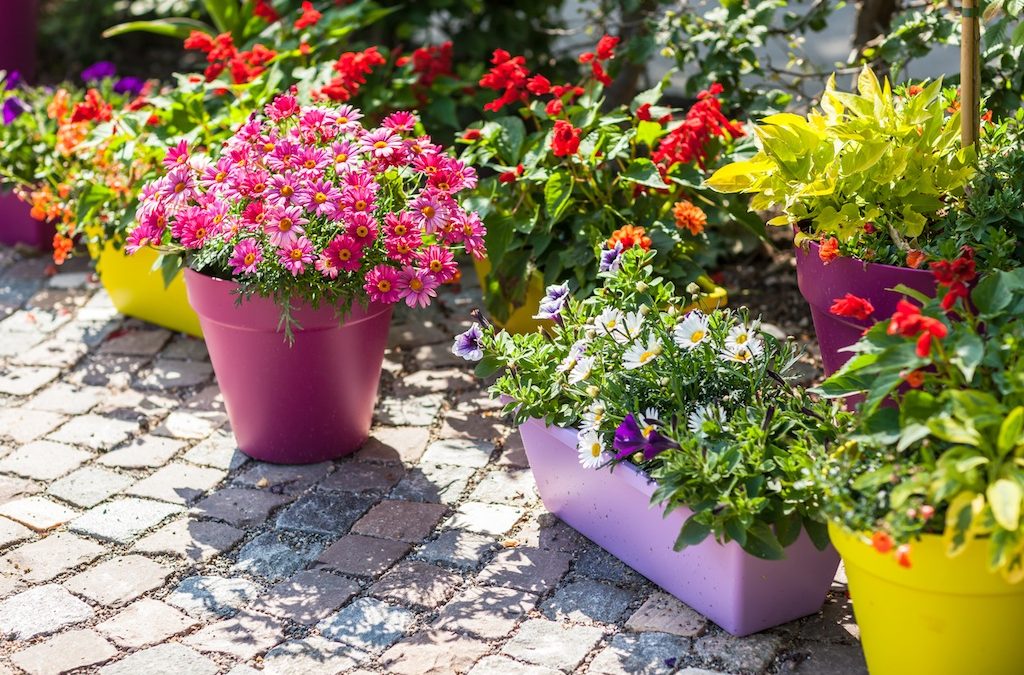Container gardening is a great way to maximise small spaces and still grow all the herbs, flowers and edibles you need. Container plants also add versatility to gardens large and small, providing a focal point and adding colour and appeal.
What container should I use?
Any pot or container is suitable for planting as long as it has good drainage holes and is larger than the rootball/bag of the plant you have chosen. Think about how large the plant will grow – large plants require large pots. You may also need a saucer or pot feet to protect the surface of where you are placing it. Consider the location of your pot and choose plants to suit, ferns in shady areas, and succulents in hot dry areas or flowering plants in semi-protected areas.
Our Top Tips
Potting mix
The choice of potting mix is the key to success. We recommend you use a premium tub or container mix as these contain water storage crystals, a wetting agent that spreads moisture to the roots, along with slow release fertilisers which are crucial for getting good results in pots. Water crystals are super absorbent and hold 200 times their own weight in water. The water crystals swell when water is added and act as a water reservoir. The crystals shrink as the water is taken up by the plant, and expand again when the plant is watered. These premium potting mixes are especially good for plants growing in hanging baskets and terracotta pots.
It is not advisable to use garden soil or compost instead of potting mix in your pots and tubs. Compost generates heat as it breaks down and like soil, compacts.
This starves the plant of oxygen and fertiliser.
Water is important
Plants grown in containers dry out quicker than plants in your garden. As the plant grows and the root ball becomes denser, it becomes harder for water to penetrate.
Water plants daily in summer – early morning or late afternoon is best. Light summer showers will not be enough to thoroughly water plants in containers, so plants will still need watering even after rain. In areas of severe frost it is not advisable to water containers in winter as the water can freeze and cause your pot to crack.
Fertiliser
Additional fertiliser will be required to ensure continuous flowering, and to maintain plant vigour and health. Budget potting mixes contain 3-4 month controlled release fertiliser, and premium mixes 8-9 month controlled release fertiliser. With regular watering, fertilisers are leached out of the potting mix. Throughout the growing season, fortnightly feeding with a liquid or soluble fertiliser is a good idea. We recommend Tui Seaweed Tonic. A side dressing of slow release granular fertiliser will be beneficial to flowering plants.
Re-potting and potting-on
 After selecting the right plant, pot and place, consider how long your plant will be in the container. Trees, shrubs, succulents and alpines do not need to be re-potted every year and will survive quite well for a number of years with regular watering and feeding. Re-potting trees and shrubs after a while can be difficult as the roots become tightly meshed. To remove you may need to run a knife around the outside of the plant’s root ball to loosen it up. Once the plant is removed, and before replanting, gently break-up the roots to stimulate new growth. Remove old potting mix from the root ball and don’t be scared to prune the roots as long as you prune the foliage as well. Always re-pot plants to the same level of the potting mix in the previous pot.
After selecting the right plant, pot and place, consider how long your plant will be in the container. Trees, shrubs, succulents and alpines do not need to be re-potted every year and will survive quite well for a number of years with regular watering and feeding. Re-potting trees and shrubs after a while can be difficult as the roots become tightly meshed. To remove you may need to run a knife around the outside of the plant’s root ball to loosen it up. Once the plant is removed, and before replanting, gently break-up the roots to stimulate new growth. Remove old potting mix from the root ball and don’t be scared to prune the roots as long as you prune the foliage as well. Always re-pot plants to the same level of the potting mix in the previous pot.
Ideal container plants
Trees and shrubs
Camelias, citrus, hebes, hydrangea, bay, olive and maples can be planted on their own in one large pot as a feature.
Evergreen or deciduous shrubs are also suitable. Roses also grow well in containers, especially floribunda and miniature types.
Annuals
For instant effect and a colourful displays use lobelia, pansy, viola, petunias and snap dragons
Perennials
Daisies, lavender, geranium, pelargonium, verbena, tropical impatiens and fuchsia.
Attractive large leafed perennials, such as hostas, do well when grown in shady locations.
Flowering bulbs
Spring and summer flowering bulbs are great in pots. Bulbs enjoy a well-drained soil and so potting mix is best. Consider spring flowering bulbs such as daffodils, tulips, freesias, hyacinths, grape hyacinths and crocus, or summer flowering bulbs like begonias dwarf canna lilies, calla lilies, dahlias and lilies. Once the foliage has died down, plant spring flowering bulbs into the garden or remove them from the pot, knocking off the potting mix and store over winter in a cool dry place.
Succulents
Drought tolerant plants need very little maintenance and can stay in the same pot for several years. When planting succulents, include some fine gravel with the potting mix to improve drainage.
Fruits and vegetables
Strawberries, citrus, dwarf fruit trees, potatoes, tomatoes, lettuce and herbs
A huge variety of fruit and vegetables can be grown in pots and containers. This is ideal if you have a smaller garden.
















